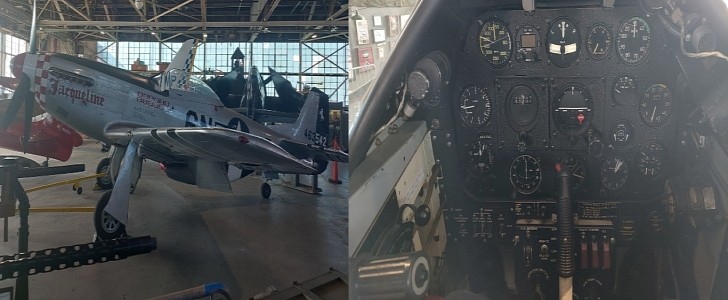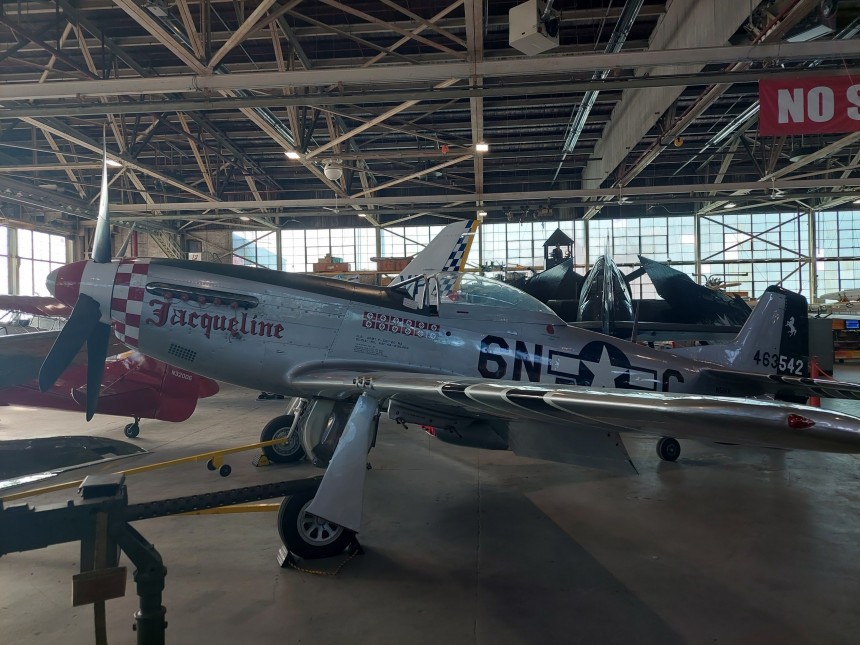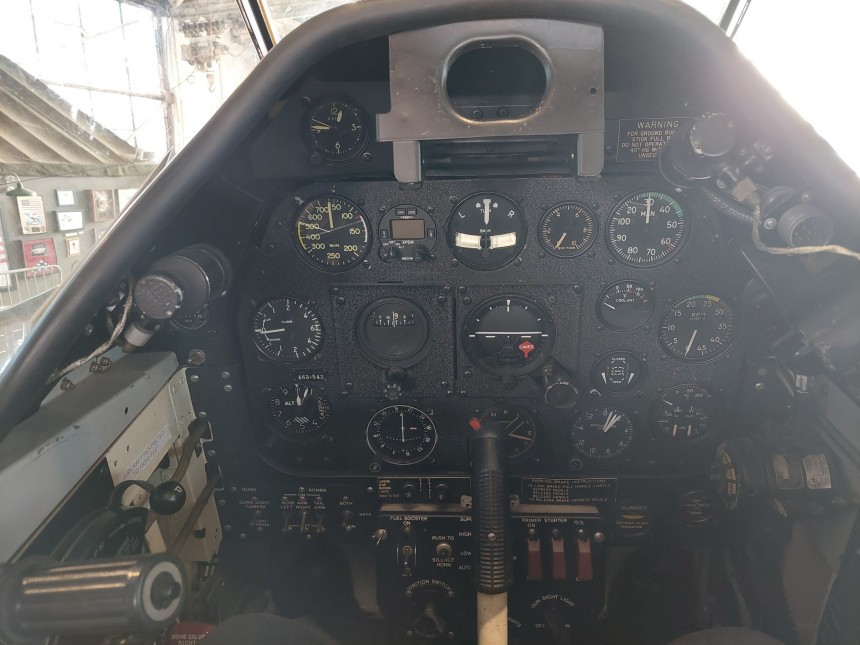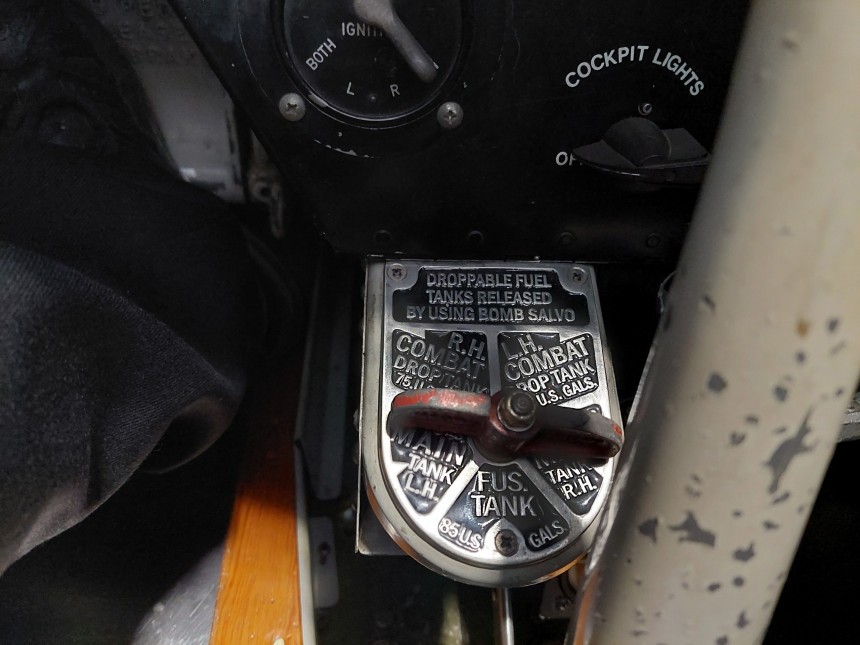No American military aircraft ever made has a mythos and a cultural impact anything like the North American P-51 Mustang. Say what you will about whether it's the legitimate best single-engined fighter of the war or not. But when most "normies" think of old warplanes, they think of the Mustang.
The Mustang is arguably even more famous for its roles in iconic feature films, TV shows, and wargaming than it was when it helped batter the Axis powers into submission during the war. But there are a handful of places where you can still marvel at the gorgeous fighter in person, and an even smaller number will let you sit in the pilot's seat.
The American AirPower Museum in Farmingdale, New York, is once such place. Although they'll ask for a tax-exempt charitable donation to the Federal 501 (C)(3) approved non-profit for a seat in the cockpit. Not a bother, considering the once-in-a-lifetime opportunity to meet Jacquline, otherwise known as North American Aviation P-51D Mustang serial no 44-63542. You tell us which of those two names is the more appealing one.
There's a bit of confusion regarding the exact origins of this particular Mustang. The serial number on the tailfin is 463542, indicating it was built sometime after the war, in 1946, at least according to some of the staff. The official website for the museum contradicts this theory. It says the plane left the Inglewood, California headquarters of North American Aviation in November 1944. It was then purported to have served with several Air National Guard and Air Defense Command units until 1958.
After this, Jacqueline would be civilian-owned and in the personal collection of Tom Contri of Reno, Nevada, until 2017, and the $2,000,000 plane was delivered to the museum in 2018.
Ultimately, it doesn't matter how old Jacqueline is. What matters is that it's one of (if not the) cleanest and most well preserved P-51D Mustangs anywhere in the world. And I got to sit in the cockpit, oh happy days!
I was more than a little nervous when the museum's exhibit designer and collection coordinator, Larry Starr, graciously lifted Jacqueline's restrictive barrier and allowed me to get within five feet of the plane. Not the least because the black pants I purchased at Wal-Mart 20 minutes before were a few sizes too small, and were constricting me like an anaconda's death grip.
If anything, it made me feel more spiritually connected to the pilots who once flew in this plane in a very roundabout and poorly thought out kind of way. Fighter pilots in those days often wore ill-fitting and uncomfortable flight suits inside the cramped single-seat cockpit. Although it's safe to say all of them had more guts than I'll ever have.
The museum's many knowledgeable and friendly staff assured me there was not much my clumsy and uncoordinated rear-end could do to mess things up as I cautiously climbed the wing and walked up to the cockpit seat, as so many pilots have before. Apart from hitting the landing gear lever with my shoes and plopping the plane destructively onto the hangar floor, that is. No pressure...
Amazingly, I was able to squeeze my 215 lb and five-foot-ten frame (67.5 kg and 1.78m) into the pilot's seat without breaking the plane or splitting my pants in front of what looked like half the museum's staff.
Once safely inside this plane, there's a couple of immediate sensory indicators that you're in something extraordinary. Firstly and most prominently, there's a distinct smell that emanates from genuine aircraft of this era. One of slightly musty canvas seating and authentic World War Two vintage metal forging. Every dash, every dial, and switch occupying the cluttered but surprisingly intuitive instrument panel has a purpose in flight well above my understanding of aviation. A purpose that is still vital in flights today.
The only visible modification inside the cockpit is a tiny LCD display connected to a radio system that allows the pilot to communicate on modern air-traffic frequencies. Everything else on the panel, from the speedometer to the altimeter and the flight control stick, are how they were when the plane left the Inglewood factory seven or so decades ago. Even the red trigger button for the six M2 Browning 50 cals is intact and on display, disarmed, of course.
The experience was so unreal that as soon as it was over I immediately loaded up a game of War Thunder and hopped in the cockpit view of the P51 D-20 variant to compare that with the photos I'd taken.
The only apparent difference between Jacquiline and the War Thunder variant is the placement of the dials. There was plenty of variation even within the P-51D family of fighters, so this is no issue. The view is tied together with a beautiful view of the striking quad-bladed Hamilton Standard propeller, which is, of course, paired with the 1,800 horsepower Anglo-American Packard Merlin V12 engine. As a lifelong fan of air combat games with this exact Mustang as one of their aircraft, it was an absolute dream come true.
I was told by staff after the fact that Jacquline had its Merlin engine started and running in the morning before civilians were allowed inside for the day. What a wonderful thing that would have been to hear! They don't call a Merlin's full-throttle howl the sound of freedom for nothing, you know. The museum often showcases the plane outside on the tarmac alongside all its housemates at local air shows.
The museum also happens to take lucky visitors up in a T-6 Texan trainer made at the same time and by the same company behind the Mustang, and you're totally not seeing me sign up for a spot next year just now, no way.
Many, many thanks to Larry Starr of the American AirPower Museum for allowing me this utmost privilege of checking out one of his most prized exhibits, and further thanks to the museum's dozens of friendly and knowledgeable staff. Check back soon for more from our trip here on autoevolution.
The American AirPower Museum in Farmingdale, New York, is once such place. Although they'll ask for a tax-exempt charitable donation to the Federal 501 (C)(3) approved non-profit for a seat in the cockpit. Not a bother, considering the once-in-a-lifetime opportunity to meet Jacquline, otherwise known as North American Aviation P-51D Mustang serial no 44-63542. You tell us which of those two names is the more appealing one.
There's a bit of confusion regarding the exact origins of this particular Mustang. The serial number on the tailfin is 463542, indicating it was built sometime after the war, in 1946, at least according to some of the staff. The official website for the museum contradicts this theory. It says the plane left the Inglewood, California headquarters of North American Aviation in November 1944. It was then purported to have served with several Air National Guard and Air Defense Command units until 1958.
After this, Jacqueline would be civilian-owned and in the personal collection of Tom Contri of Reno, Nevada, until 2017, and the $2,000,000 plane was delivered to the museum in 2018.
Ultimately, it doesn't matter how old Jacqueline is. What matters is that it's one of (if not the) cleanest and most well preserved P-51D Mustangs anywhere in the world. And I got to sit in the cockpit, oh happy days!
If anything, it made me feel more spiritually connected to the pilots who once flew in this plane in a very roundabout and poorly thought out kind of way. Fighter pilots in those days often wore ill-fitting and uncomfortable flight suits inside the cramped single-seat cockpit. Although it's safe to say all of them had more guts than I'll ever have.
The museum's many knowledgeable and friendly staff assured me there was not much my clumsy and uncoordinated rear-end could do to mess things up as I cautiously climbed the wing and walked up to the cockpit seat, as so many pilots have before. Apart from hitting the landing gear lever with my shoes and plopping the plane destructively onto the hangar floor, that is. No pressure...
Amazingly, I was able to squeeze my 215 lb and five-foot-ten frame (67.5 kg and 1.78m) into the pilot's seat without breaking the plane or splitting my pants in front of what looked like half the museum's staff.
Once safely inside this plane, there's a couple of immediate sensory indicators that you're in something extraordinary. Firstly and most prominently, there's a distinct smell that emanates from genuine aircraft of this era. One of slightly musty canvas seating and authentic World War Two vintage metal forging. Every dash, every dial, and switch occupying the cluttered but surprisingly intuitive instrument panel has a purpose in flight well above my understanding of aviation. A purpose that is still vital in flights today.
The experience was so unreal that as soon as it was over I immediately loaded up a game of War Thunder and hopped in the cockpit view of the P51 D-20 variant to compare that with the photos I'd taken.
The only apparent difference between Jacquiline and the War Thunder variant is the placement of the dials. There was plenty of variation even within the P-51D family of fighters, so this is no issue. The view is tied together with a beautiful view of the striking quad-bladed Hamilton Standard propeller, which is, of course, paired with the 1,800 horsepower Anglo-American Packard Merlin V12 engine. As a lifelong fan of air combat games with this exact Mustang as one of their aircraft, it was an absolute dream come true.
The museum also happens to take lucky visitors up in a T-6 Texan trainer made at the same time and by the same company behind the Mustang, and you're totally not seeing me sign up for a spot next year just now, no way.
Many, many thanks to Larry Starr of the American AirPower Museum for allowing me this utmost privilege of checking out one of his most prized exhibits, and further thanks to the museum's dozens of friendly and knowledgeable staff. Check back soon for more from our trip here on autoevolution.

















